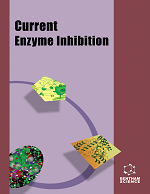- Home
- A-Z Publications
- Current Enzyme Inhibition
- Previous Issues
- Volume 4, Issue 2, 2008
Current Enzyme Inhibition - Volume 4, Issue 2, 2008
Volume 4, Issue 2, 2008
-
-
Impact of Omega-3 and Trans Fatty Acids on Vascular Remodeling:Opposing Roles in Cardiovascular Health
More LessAuthors: Rafat A. Siddiqui, Kevin Harvey, Steven J. Miller and Gary ZalogaOmega-3 polyunsaturated fatty acids (n-3 PUFAs) have well-recognized cardio-beneficial effects that include reductions in atherosclerotic lesions and mortality from myocardial infarction, stroke, and sudden cardiac death. In contrast, evidence suggests that more than 30,000 premature coronary deaths per year in the US alone are associated with consumption of high levels of trans isomers of unsaturated fatty acids, or t Read More
-
-
-
Mechanisms of Interaction of Nitric Oxide (NO) and its Metabolites with Enzymes Responsible for the Physiological Effects of NO
More LessIt is known that nitric oxide (NO) realizes its basic physiological effects by affecting activity of specific enzymes, such as guanylate cyclase and caspase. Since NO itself in physiological conditions is a short-lived substance, it is considered that it acts by means of some metabolites such as nitrosothiols and some nitro-compounds, which may serve as NO - donors. These NO metabolites are relatively stable substances and th Read More
-
-
-
Neutrophil Elastase Inhibition: A New Cancer Therapy
More LessAuthors: Takashi Sato, Miwa Yoshida, Satoshi Takahashi, Takashi Fukutomi and Jun-Ichi YamashitaCancer cells enter the circulation and attach to endothelial cells to pass through them and migrate over a distance to enter the tissue of the metastatic organ to proliferate there. In the same way, neutrophils drift in blood and adhere loosely to adhesive molecules on the endothelial cells in an inflamed area. They roll along the endothelial cells and then adhere closely to the endothelial cells to penetrate vessel wall. Neutro Read More
-
-
-
Study of the Catalytic Mechanism of the Enzyme Catalase on Organic Hydroperoxides in Non-Polar Organic Solvent
More LessCatalases are enzymes composed of a protein and a prosthetic group made up of iron porphyrin. The aim of the present research, was to study the catalytic mechanism of catalase on organic hydroperoxides rather than on hydrogen peroxide, when operating in organic solvents such as decane or hexane. The investigation was performed using gas chromatography and amperometry to analyse the reagents and reaction product Read More
-
Volumes & issues
-
Volume 20 (2024)
-
Volume 19 (2023)
-
Volume 18 (2022)
-
Volume 17 (2021)
-
Volume 16 (2020)
-
Volume 15 (2019)
-
Volume 14 (2018)
-
Volume 13 (2017)
-
Volume 12 (2016)
-
Volume 11 (2015)
-
Volume 10 (2014)
-
Volume 9 (2013)
-
Volume 8 (2012)
-
Volume 7 (2011)
-
Volume 6 (2010)
-
Volume 5 (2009)
-
Volume 4 (2008)
-
Volume 3 (2007)
-
Volume 2 (2006)
-
Volume 1 (2005)
Most Read This Month
Article
content/journals/cei
Journal
10
5
false
en


